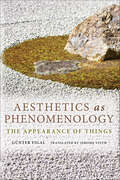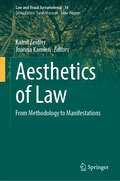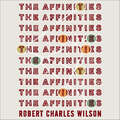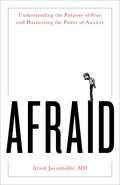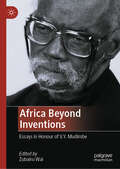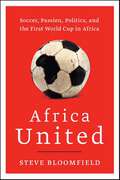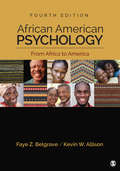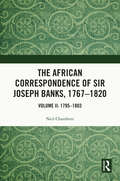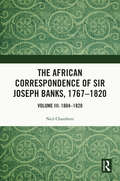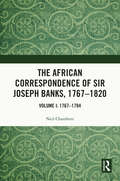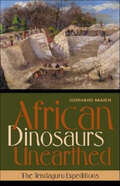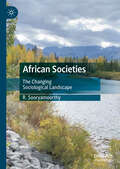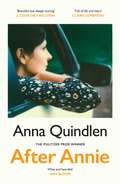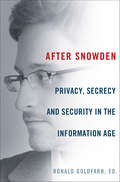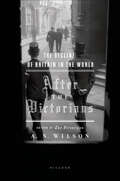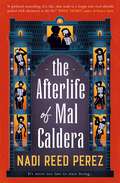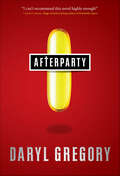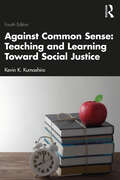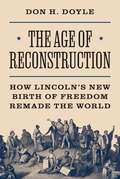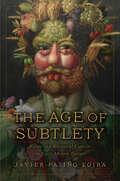- Table View
- List View
Aesthetic Procedures: Nurse Practitioner's Guide to Cosmetic Dermatology
by Beth HaneyThis second edition is a resource that offers guidance to advanced practice providers who are experienced or novice aesthetic practitioners and would like to improve their aesthetic practice and enhance patient safety and satisfaction. This new book reviews skin structure and anatomy, what happens as facial structures age, the effects of aging coupled with environmental exposures, pharmacology of medications used in aesthetics, light-based device properties, patient selection, danger zones, complications, new treatments, and benefits of treatments. In addition, it includes suggestions on how to communicate with patients to achieve successful outcomes. Aesthetic Procedures: Nurse Practitioner's Guide to Cosmetic Dermatology provides practitioners a one-source resource to attain more in-depth learning about cosmetic dermatology. Although there are several texts on individual aspects of aesthetic medicine, there is no all-inclusive book for advanced practice providers. This book also affords the primary care practitioner the opportunity to add minimally invasive cosmetic dermatology procedures to their practice and perform the treatments safely, efficiently and effectively while avoiding common mistakes and minimizing complication risks. Education and hands-on practice and training are paramount in creating a safe patient environment and as more clinicians turn to aesthetics to augment their practice, this book will be a valuable resource for practitioners all over the world.
Aesthetics as Phenomenology: The Appearance of Things (Studies in Continental Thought)
by Günter FigalConnecting aesthetic experience with our experience of nature or with other cultural artifacts, Aesthetics as Phenomenology focuses on what art means for cognition, recognition, and affect—how art changes our everyday disposition or behavior. Günter Figal engages in a penetrating analysis of the moment at which, in our contemplation of a work of art, reaction and thought confront each other. For those trained in the visual arts and for more casual viewers, Figal unmasks art as a decentering experience that opens further possibilities for understanding our lives and our world.
Aesthetics of Law: From Methodology to Manifestations (Law and Visual Jurisprudence #14)
by Kamil Zeidler Joanna KamieńThe aesthetics of law deals with the relationship between law and beauty by searching for aesthetic values in the law itself (an internal perspective), by finding material related to law in art and culture (an external perspective), and, lastly, by demonstrating the impact of legal norms on what can be broadly understood as beauty (law as a tool of aestheticization). Regarding all these phenomena, the aesthetics of law ultimately allows us to see the law more clearly and more profoundly. What is more, the law does not function, nor has it ever functioned, separately from its means of expression, which are incontrovertibly subject to aesthetic interpretation. If we think about law in this way, perceiving not only the message, but also the manner in which it is conveyed, the whole set of means and tools used, the perfection and beauty of the form, then we will see art in it. After all, the widely known and still applicable ancient maxim ius est ars boni et aequi equates law and art. This alone should be an argument for aesthetic reflection on the law, a field of endeavour that should never have been abandoned. The book’s twenty-three chapters, written by scholars from various countries and three continents, are thematically diverse. In them we present the manifestations of the aesthetics of law from an external perspective. If we accept a definition of the concept of law that is as broad as possible, not only as a synonym of a certain formalized normative system, but also including the process of its creation (legislation), its application and interpretation (jurisprudence), and even teaching on and research into it (doctrine), we can identify a wealth of aesthetic references in the law. A broadly understood aesthetics of law, approached solely from an external perspective, covers such disciplines as law and literature, the aesthetics of legal rhetoric, the trial as performance, the aesthetics ofcourthouse architecture, law in the fine arts, law in film, law and music, pictorial law, symbols of the law and legal symbols, symbols of the state and power, legal archaeology etc. The field of research is, therefore, wide. In addition to topics traditionally and obviously associated with the aesthetics of law, such as law and literature, law in the fine arts, and court rhetoric, there are chapters on e.g. legal ethics and trademarks. All authors share the belief that beauty in law is important, even when it is hidden in a caricature. Further, they argue for restoring the aesthetics of law to its proper place in philosophical and legal discourse, as doing so would yield a host of benefits for the addressees of law.
The Affinities
by Robert Charles WilsonIn our rapidly-changing world of "social media", everyday people are more and more able to sort themselves into social groups based on finer and finer criteria. In the near future of Robert Charles Wilson's The Affinities, this process is supercharged by new analytic technologies--genetic, brain-mapping, behavioral. To join one of the twenty-two Affinities is to change one's life. It's like family, and more than family. Your fellow members aren't just like you, and they aren't just people who are likely to like you. They're also the people with whom you can best cooperate in all areas of life--creative, interpersonal, even financial. At loose ends both professional and personal, young Adam Fisk takes the suite of tests to see if he qualifies for any of the Affinities, and finds that he's a match for one of the largest, the one called Tau. It's utopian—at first. Problems in all areas of his life begin to simply sort themselves out, as he becomes part of a global network of people dedicated to helping one another—to helping him. But as the differing Affinities put their new powers to the test, they begin to rapidly chip away at the power of governments, of global corporations, of all the institutions of the old world. Then, with dreadful inevitability, the different Affinities begin to go to war--with one another. What happens next will change Adam, and his world, forever.At the Publisher's request, this title is being sold without Digital Rights Management Software (DRM) applied.
Afraid: Understanding the Purpose of Fear and Harnessing the Power of Anxiety
by Arash JavanbakhtSELF-HELP/ANXIETY. A psychiatrist and neuroscientist describes fear and anxiety in our brain and body and how they color many aspects of a modern human's life. In a way that is accessible to the public, he explains why we love to be scared; the link between bravery, meaning, aggression, creativity, and fear; and the diseases of fear and anxiety and how we manage them. ARASH JAVANBAKHT, MD, is director of the Stress, Trauma, and Anxiety Research Clinic STARC) at Wayne State University, School of Medicine. He is renowned for his research of biology and innovative technologies for treatments of anxiety and PTSD. Dr. Javanbakht's public scholarly work has been read by millions and featured on CNN, NPR, BBC, PBS, Scientific American, and many others.
Africa Beyond Inventions: Essays in Honour of V.Y. Mudimbe
by Zubairu WaiAfrica Beyond Inventions is a rich critical engagement with the work of V.Y. Mudimbe. For decades, Mudimbe advanced a distinctive and erudite critical project that contributes to various bodies of knowledge in fields such as philosophy, anthropology, theology, postcolonial studies, decolonial theory, literary criticism, cultural studies, prose fiction, and African studies more broadly. A decade after his retirement and in the expansive spirit of his work, this volume stages a productive engagement with Mudimbe’s remarkable and capacious body of work and the conceptual, epistemic, methodological, and ethical challenges it poses for the modern disciplines, specifically in relation to Africa. It situates Mudimbe in his proper place as a complex and significant thinker whose extraordinary contributions to various bodies of knowledge deserves to be recognised and better apprehended for what it has taught and continues to teach about the discursivity of the modern disciplines and the possibility of decolonising their colonising imprints in a moment that has been characterised as a decolonial turn. Through these engagements, the volume honours the intellectual legacy of one of Africa’s most brilliant minds and make his work accessible to a new generation of readers.
Africa-EU Relations and the African Continental Free Trade Area: Redefining the Dynamics of Power and Economic Partnership in a Complex Global Order
by Samuel Ojo Oloruntoba Leon Mwamba TshimpakaThis book examines the establishment and implementation of the AfCFTA, which is the largest free trade area globally, covering 54 African countries. It explores how this initiative has the potential to reshape Africa-EU relations by promoting intra-African trade, economic integration, and diversification, as well as inter- regional trade. Both continents have potential to serve as global actors in reshaping the global order in ways that can affect how multilateralism foster inclusive development. However, whether this will happen would be a function of how the EU and AU define their interests and relationship.
Africa United: Soccer, Passion, Politics, and the First World Cup in Africa
by Steve BloomfieldAfrica United is the story of modern day Africa told through its soccer. Travelling across thirteen countries, from Cairo to the Cape, Steve Bloomfield, the former Africa Correspondent for The Independent, meets players and fans, politicians and rebel leaders, discovering the role that soccer has played in shaping the continent. This wide-ranging and incisive book investigates Africa’s love of soccer, its increasing global influence, the build-up to the 2010 World Cup itself and the social and political backdrop to the greatest show on earth.
African American Psychology: From Africa to America
by Faye Z. Belgrave Kevin W. AllisonAfrican American Psychology: From Africa to America, Fourth Edition provides comprehensive coverage of the field of African American psychology. Authors Faye Z. Belgrave and Kevin W. Allison skillfully convey the integration of African and American influences on the psychology of African Americans using a consistent theme throughout the text—the idea that understanding the psychology of African Americans is closely linked to understanding what is happening in the institutional systems in the United States. The Fourth Edition reflects notable advances and important developments in the field over the last several years, and includes evidence-based practices for improving the overall well-being of African American communities. New to the Fourth Edition Coverage of current issues affecting African Americans and causing changes in the social-political environment include the Black Lives Matter movement, racial trauma, and more. Content from blogs has been added to chapter-opening cover stories to reflect the more modern ways news and information are obtained. More coverage of literature and research on Blacks throughout the diaspora, especially in Africa, provide historical context and documents heterogeneity among African Americans in the United States. Expanded coverage of topics as a result of recent research includes LGBTQ individuals, African American fathers, colorism, intersectionality, electronic cigarettes, social media, and more.
African American Psychology: From Africa to America
by Faye Z. Belgrave Kevin W. AllisonAfrican American Psychology: From Africa to America, Fourth Edition provides comprehensive coverage of the field of African American psychology. Authors Faye Z. Belgrave and Kevin W. Allison skillfully convey the integration of African and American influences on the psychology of African Americans using a consistent theme throughout the text—the idea that understanding the psychology of African Americans is closely linked to understanding what is happening in the institutional systems in the United States. The Fourth Edition reflects notable advances and important developments in the field over the last several years, and includes evidence-based practices for improving the overall well-being of African American communities. New to the Fourth Edition Coverage of current issues affecting African Americans and causing changes in the social-political environment include the Black Lives Matter movement, racial trauma, and more. Content from blogs has been added to chapter-opening cover stories to reflect the more modern ways news and information are obtained. More coverage of literature and research on Blacks throughout the diaspora, especially in Africa, provide historical context and documents heterogeneity among African Americans in the United States. Expanded coverage of topics as a result of recent research includes LGBTQ individuals, African American fathers, colorism, intersectionality, electronic cigarettes, social media, and more.
The African Correspondence of Sir Joseph Banks, 1767–1820: Volume II: 1795–1803
by Neil ChambersThis edition brings together in three fully edited volumes the correspondence and associated papers of Sir Joseph Banks regarding European and especially British exploration of Africa from 1767–1820, for the first time publishing this globally scattered material in one place, thereby revolutionizing its availability and understanding of the activities of a key figure who helped organize and publish a series of missions to penetrate the African interior, mainly from West Africa and by crossing the Sahara from Cairo and Tripoli. Banks was a founder in 1788 of the African Association, which mounted many of these missions, including those of Mungo Park to explore the River Niger, and J.L. Burkhardt exploring Syria, Arabia and Egypt. At the time, little was known about the African interior, its peoples, kingdoms and resources, and the aim of the African Association under Banks was to discover what lay there, to make contact with and study its societies, to map them and their lands and help establish trading links. Banks also maintained a lively correspondence with British diplomatic representatives in North Africa, such as James Mario Matra at Tangier and Henry Salt in Cairo, who were a rich source of news. Moreover, as unofficial director of the royal gardens at Kew he sent pioneering plant collectors to gather plants in South Africa, vastly boosting knowledge of this region’s important flora. At home, he corresponded with politicians, government officials, entrepreneurs, navigators, naturalists and campaigners like William Wilberforce about a great range of issues surrounding Africa. This work is multi-disciplinary and will stand alongside existing series of Banks’s correspondence published by Neil Chambers (Scientific Correspondence, 2007; Indian and Pacific Correspondence, 2007–14). It will appeal to scholars of African history in the Early Modern Period, to those studying exploration and collecting as well as those interested in natural history, the history of science, geography, cartography and the Enlightenment. An Introduction, detailed Calendar of Correspondents, Timelines for each volume and a comprehensive Index supplement the footnotes to nearly 800 documents included in this fascinating and comprehensive new series.
The African Correspondence of Sir Joseph Banks, 1767–1820: Volume III 1804–1820
by Neil ChambersThis edition brings together in three fully edited volumes the correspondence and associated papers of Sir Joseph Banks regarding European and especially British exploration of Africa from 1767–1820, for the first time publishing this globally scattered material in one place, thereby revolutionizing its availability and understanding of the activities of a key figure who helped organize and publish a series of missions to penetrate the African interior, mainly from West Africa and by crossing the Sahara from Cairo and Tripoli. Banks was a founder in 1788 of the African Association, which mounted many of these missions, including those of Mungo Park to explore the River Niger, and J.L. Burkhardt exploring Syria, Arabia and Egypt. At the time, little was known about the African interior, its peoples, kingdoms and resources, and the aim of the African Association under Banks was to discover what lay there, to make contact with and study its societies, to map them and their lands and help establish trading links. Banks also maintained a lively correspondence with British diplomatic representatives in North Africa, such as James Mario Matra at Tangier and Henry Salt in Cairo, who were a rich source of news. Moreover, as unofficial director of the royal gardens at Kew he sent pioneering plant collectors to gather plants in South Africa, vastly boosting knowledge of this region’s important flora. At home, he corresponded with politicians, government officials, entrepreneurs, navigators, naturalists and campaigners like William Wilberforce about a great range of issues surrounding Africa. This work is multi-disciplinary and will stand alongside existing series of Banks’s correspondence published by Neil Chambers (Scientific Correspondence, 2007; Indian and Pacific Correspondence, 2007–14). It will appeal to scholars of African history in the Early Modern Period, to those studying exploration and collecting as well as those interested in natural history, the history of science, geography, cartography and the Enlightenment. An Introduction, detailed Calendar of Correspondents, Timelines for each volume and a comprehensive Index supplement the footnotes to nearly 800 documents included in this fascinating and comprehensive new series.
The African Correspondence of Sir Joseph Banks, 1767–1820: Volume I: 1767–1794
by Neil ChambersThis edition brings together in three fully edited volumes the correspondence and associated papers of Sir Joseph Banks regarding European and especially British exploration of Africa from 1767–1820, for the first time publishing this globally scattered material in one place, thereby revolutionizing its availability and understanding of the activities of a key figure who helped organize and publish a series of missions to penetrate the African interior, mainly from West Africa and by crossing the Sahara from Cairo and Tripoli. Banks was a founder in 1788 of the African Association, which mounted many of these missions, including those of Mungo Park to explore the River Niger, and J.L. Burkhardt exploring Syria, Arabia and Egypt. At the time, little was known about the African interior, its peoples, kingdoms and resources, and the aim of the African Association under Banks was to discover what lay there, to make contact with and study its societies, to map them and their lands and help establish trading links. Banks also maintained a lively correspondence with British diplomatic representatives in North Africa, such as James Mario Matra at Tangier and Henry Salt in Cairo, who were a rich source of news. Moreover, as unofficial director of the royal gardens at Kew he sent pioneering plant collectors to gather plants in South Africa, vastly boosting knowledge of this region’s important flora. At home, he corresponded with politicians, government officials, entrepreneurs, navigators, naturalists and campaigners like William Wilberforce about a great range of issues surrounding Africa. This work is multi-disciplinary and will stand alongside existing series of Banks’s correspondence published by Neil Chambers (Scientific Correspondence, 2007; Indian and Pacific Correspondence, 2007–14). It will appeal to scholars of African history in the Early Modern Period, to those studying exploration and collecting as well as those interested in natural history, the history of science, geography, cartography and the Enlightenment. An Introduction, detailed Calendar of Correspondents, Timelines for each volume and a comprehensive Index supplement the footnotes to nearly 800 documents included in this fascinating and comprehensive new series.
African Dinosaurs Unearthed: The Tendaguru Expeditions (Life of the Past)
by Gerhard MaierFrom 1907 to 1931 at Tendaguru, a remote site in present-day Tanzania, teams of German (and later British) paleontologists unearthed 220 tons of fossils, including the bones of a new dinosaur, one of the largest then known. For decades the mounted skeleton of this giant, Brachiosaurus, was the largest skeleton of a land animal on exhibit in the world. The dinosaur and other animal fossils found at Tendaguru form one of the cornerstones of our understanding of life in the Mesozoic era. Visited sporadically during the '30s and '40s, Tendaguru again became the site of scientific interest late in the 20th century. African Dinosaurs Unearthed tells the story of driven scientific adventurers working under difficult conditions and often paying the price with their health—and sometimes with their lives. Set against the background of a troubled century, the book reveals how scientific endeavors were carried on through war and political turmoil, and continue into the present day.
African Societies: The Changing Sociological Landscape
by R. SooryamoorthyThis book addresses a notable gap in African sociological knowledge by leveraging extensive empirical data covering all 54 African countries and drawing on historical insights from across the continent. Offering a nuanced understanding of African society, it signifies an unprecedented endeavour committed to unravelling the intricate tapestry of African society. The analysis presented in the book goes into the dynamic evolution of sociological topics, their interconnections with African knowledge, the identification of contemporary themes, methodological diversity, and contemporary challenges and issues of indigenisation, decolonisation, and promoting an Africa-centered sociology.
After Annie: A Novel
by Anna Quindlen&‘Candid and complex – and ultimately quite hopeful&’ Claire Lombardo&‘Beautiful and deeply moving&’ J. Courtney Sullivan&‘A story of abiding hope&’ Mary Beth Keane When Annie Brown dies suddenly, her husband, her four young children and her closest friend are left to struggle without the woman who centred their lives. Bill Brown finds himself overwhelmed, and Annie&’s best friend Annemarie is lost to old bad habits without Annie&’s support. It is Annie&’s daughter, Ali, forced to try to care for her younger brothers and even her father, who manages to maintain some semblance of their former lives for them all, and who confronts the complicated truths of adulthood. Yet over the course of the next year, while Annie looms large in their memories, all three are able to grow, to change, even to become stronger and more sure of themselves. The enduring power Annie gave to those who loved her is the power to love, and to go on without her. Written in Quindlen&’s emotionally resonant voice, and with her deep and generous understanding of people, After Annie is a story that ends with hope, a beautiful novel about how adversity can change us in profound ways. Praise for Anna Quindlen &‘Leaves the reader feeling grateful, wide awake, lucky to be alive&’ Michael Chabon &‘Simply impossible to forget&’ Alice Hoffman &‘Qualities and shades of love are this writer's strong suit, and she has the unusual talent for writing about them with so much truth and heart&’ Elizabeth Jane Howard &‘Breathtaking... Quindlen writes superbly about families, grief and betrayal. I was completely mesmerised&’ Lisa Jewell &‘Engaging, immaculately constructed storytelling&’ Guardian &‘One of our most astute chroniclers of modern life&’ New York Times Book Review &‘Brave and beautiful&’ The Times &‘Her storytelling is exemplary&’ Sunday Telegraph &‘With relentless and dazzling brilliance, Quindlen grapples with the lancing pain and the swirls of disorientation experienced by anyone who has loved and lost&’ Daily Mail &‘A wise, closely observed, achingly eloquent book&’ Huffington Post &‘Overwhelmingly moving&’ New York Times
After Dark: The Night Owl Trilogy (The Night Owl Trilogy #3)
by M. PierceIn the final novel of the Night Owl Trilogy from bestselling author M. Pierce, can a passion that has withstood many ordeals become a love strong enough to last a lifetime?Matt Sky is trying to return to normal, having faked his death and come back to life. He and Hannah move back in together, and Matt attempts to put his demons to rest as they strive to grow their relationship into something durable and honest. But as the two become more and more entangled, and the heat between them intensifies in all the best possible ways, Matt's desire for Hannah ignites cravings he has kept at bay for a long, long time...Hannah finally has the life she's always wanted: she's pursuing her career as a literary agent at Granite Wing Agency, she is writing her first novel, and she is living with her hot, passionate lover. But as Matt and Hannah explore a new intimacy, Hannah finds that there are parts of Matt-dark, wild, uncontrollable parts-that he has yet to show her...that he has yet to show anyone...Under the surface of Matt and Hannah's domestic bliss, deeply buried secrets burn, and all of a sudden, the least foreseen obstacle threatens to shatter everything they've worked so hard for.
After Snowden: Privacy, Secrecy and Security in the Information Age
by Ronald GoldfarbWas Edward Snowden a patriot or a traitor? Just how far do American privacy rights extend?And how far is too far when it comes to government secrecy in the name of security? These are just a few of the questions that have dominated American consciousness since Edward Snowden exposed the breath of the NSA's domestic surveillance program. In these seven previously unpublished essays, a group of prominent legal and political experts delve in to life After Snowden, examining the ramifications of the infamous leak from multiple angles: • Washington lawyer and literary agent RONALD GOLDFARB acts as the book's editor and provides an introduction outlining the many debates sparked by the Snowden leaks.• Pulitzer Prize winning journalist BARRY SIEGEL analyses the role of the state secrets provision in the judicial system.• Former Assistant Secretary of State HODDING CARTER explores whether the press is justified in unearthing and publishing classified information. • Ethics expert and dean of the UC Berkley School of Journalism EDWARD WASSERMAN discusses the uneven relationship between journalists and whistleblowers.• Georgetown Law Professor DAVID COLE addresses the motives and complicated legacy of Snowden and other leakers.• Director of the National Security Archive THOMAS BLANTON looks at the impact of the Snowden leaks on the classification of government documents.• Dean of the University of Florida Law School JON MILLS addresses the constitutional right to privacy and the difficulties of applying it in the digital age.
After the Victorians: The Decline of Britain in the World
by A. N. WilsonThe distinguished historian A.N. Wilson has charted, in vivid detail, Britain's rise to world dominance, a tale of how one small island nation came to be the mightiest, richest country on earth, reigning over much of the globe. Now in his much anticipated sequel to the classic The Victorians, he describes how in little more than a generation Britain's power and influence in the world would virtually dissolve. In After the Victorians, Wilson presents a panoramic view of an era, stretching from the death of Queen Victoria in 1901 to the dawn of the cold war in the early 1950s. He offers riveting accounts of the savagery of World War I and the world-altering upheaval of the Communist Revolution. He explains Britain's role in shaping the destiny of the Middle East. And he casts a bright new light on the World War II years: Britain played a central role in defeating Germany but at a severe cost. The nation would emerge from the war bankrupt and fatally weakened, sidelined from world politics, while America would assume the mantle of dominant world power, facing off against the Soviet Union in the cold war. Wilson's perspective is not confined to the trenches of the battlefield and the halls of parliament: he also examines the parallel story of the beginnings of Modernism-he visits the novelists, philosophers, poets, and painters to see what they reveal about the activities of the politicians, scientists, and generals.Blending military, political, social, and cultural history of the most dramatic kind, A.N. Wilson offers an absorbing portrait of the decline of one of the world's great powers. The result is a fresh account of the birth pangs of the modern world, as well as a timely analysis of imperialism and its discontents.
After the Worst has Happened: Tales from a funeral director on the lighter side of death
by Richard GoslingWhen Richard Gosling's young daughter faced emergency surgery, a colleague carelessly asked what would happen if she died. In that moment, Richard was forced to picture his own daughter's funeral, and the people who are there to help families after the worst has happened.Aged 40, Richard left his job in the public service and started preparing coffins, driving hearses, assisting in the mortuary and bringing in the deceased from hospitals and nursing homes, slowly working his way up to become operations manager of a venerable Sydney funeral home.After the Worst Has Happened lifts the curtain on a world we all try to avoid but must pass through. It shows the lighter side of death amid all its other facets, as Richard steers families through heartbreak, anger and grief while holding space for love and acceptance. Ultimately, it's about how extraordinarily beautiful it can be to spend a daily life surrounded by our final rite of passage.
The Afterlife of Mal Caldera
by Nadi Reed PerezMal's life is over. Her afterlife is only just beginning...By turns irreverently funny and deeply moving, this debut contemporary fantasy is perfect for fans of They Both Die at the End and The Invisible Life of Addie LaRue.Mal Caldera—former rockstar, retired wild-child and excommunicated black sheep of her Catholic family—is dead. Not that she cares. She only feels bad that her younger sister, Cris, has been left to pick up the pieces Mal left behind. While her fellow ghosts party their afterlives away at an abandoned mansion they call the Haunt, Mal is determined to make contact with Cris from beyond the grave. She enlists the help of a reluctant local medium, Ren, and together, they concoct a plan to pass on a message to Cris. But the more time they spend together, the more they begin to wonder what might have been if they'd met before Mal died.Mal knows it&’s wrong to hold on so tightly to her old life. Bad things happen to ghosts who interfere with the living, and Mal can't help wondering if she&’s hurting the people she loves by hanging around, haunting their lives. But Mal has always been selfish, and letting go might just be the hardest thing she's ever had to do. Funny, emotional and life-affirming, The Afterlife of Mal Caldera will have readers laughing one minute and sobbing the next.
Afterparty
by Daryl GregoryA science fiction thriller, award-winning author Daryl Gregory's Afterparty features a scientist on a mind-bending and violent chase across Canada and the U.S. to undue the harm her creation has done and save civilization.It begins in Toronto, in the years after the smart drug revolution. Any high school student with a chemjet and internet connection can download recipes and print drugs, or invent them. A seventeen-year-old street girl finds God through a new brain-altering drug called Numinous, used as a sacrament by a new Church that preys on the underclass. But she is arrested and put into detention, and without the drug, commits suicide.Lyda Rose, another patient in that detention facility, has a dark secret: she was one of the original scientists who developed the drug. With the help of an ex-government agent and an imaginary, drug-induced doctor, Lyda sets out to find the other three survivors of the five who made the Numinous in a quest to set things right.At the Publisher's request, this title is being sold without Digital Rights Management Software (DRM) applied.
Against Common Sense: Teaching And Learning Toward Social Justice
by Kevin K. KumashiroWhat does it mean to teach for social justice? Drawing on his own classroom experiences, leading author and educator Kevin K. Kumashiro examines various aspects of anti-oppressive teaching and learning and their implications for six different subject areas and various grade levels. Celebrating 20 years as a go-to resource for K-12 teachers and teacher educators, this 4th edition of the bestselling Against Common Sense: Teaching and Learning Toward Social Justice features:• An expanded introduction that examines teaching in today’s context of censorship and attacks on diversity, democracy, and teaching truth;• New sections on teacher preparation, social studies, reading and writing, and the arts;• Updated lists of resources in every chapter;• Graphics, teacher responses, and discussion questions to enhance comprehension and help translate theory into practice across the disciplines.Compelling and accessible, the 4th edition of Against Common Sense continues to offer readers the tools they need to begin teaching against their commonsensical assumptions and toward democracy and justice.
The Age of Reconstruction: How Lincoln’s New Birth of Freedom Remade the World (America in the World #59)
by Don H. DoyleA sweeping history of how Union victory in the American Civil War inspired democratic reforms, revolutions, and emancipation movements in Europe and the AmericasThe Age of Reconstruction looks beyond post–Civil War America to tell the story of how Union victory and Lincoln’s assassination set off a dramatic international reaction that drove European empires out of the Americas, hastened the end of slavery in Latin America, and ignited a host of democratic reforms in Europe.In this international history of Reconstruction, Don Doyle chronicles the world events inspired by the Civil War. Between 1865 and 1870, France withdrew from Mexico, Russia sold Alaska to the United States, and Britain proclaimed the new state of Canada. British workers demanded more voting rights, Spain toppled Queen Isabella II and ended slavery in its Caribbean colonies, Cubans rose against Spanish rule, France overthrew Napoleon III, and the kingdom of Pope Pius IX fell before the Italian Risorgimento. Some European liberals, including Victor Hugo and Giuseppe Mazzini, even called for a “United States of Europe.” Yet for all its achievements and optimism, this “new birth of freedom” was short-lived. By the 1890s, Reconstruction had been undone in the United States and abroad and America had become an exclusionary democracy based on white supremacy—and a very different kind of model to the world.At home and abroad, America’s Reconstruction was, as W.E.B. Du Bois wrote, “the greatest and most important step toward world democracy of all men of all races ever taken in the modern world.” The Age of Reconstruction is a bracing history of a remarkable period when democracy, having survived the great test of the Civil War, was ascendant around the Atlantic world.
The Age of Subtlety: Nature and Rhetorical Conceits in Early Modern Europe (The Early Modern Exchange)
by Javier Patiño LoiraA craze for intricate metaphors, referred to as conceits, permeated all forms of communication in seventeenth-century Italy and Spain, reshaping reality in highly creative ways. The Age of Subtlety: Nature and Rhetorical Conceits in Early Modern Europe situates itself at the crossroads of rhetoric, poetics, and the history of science, analyzing technical writings on conceits by such scholars as Baltasar Gracián, Matteo Peregrini, and Emanuele Tesauro against the background of debates on telescopic and microscopic vision, the generation of living beings, and the boundaries between the natural and the artificial. It contends that in order to understand conceits, we must locate them within the early modern culture of ingenuity that was also responsible for the engineer’s machines, the juggler’s sleight of hand, the wiles of the statesman, and the discovery of truths about nature.

